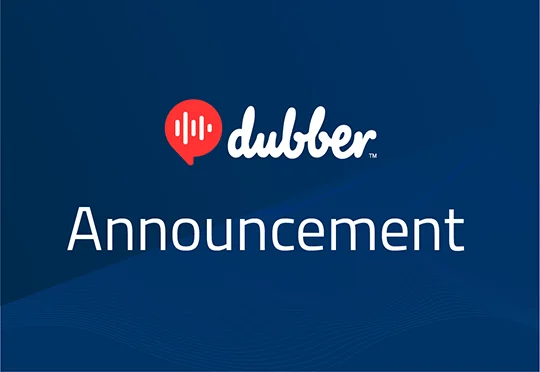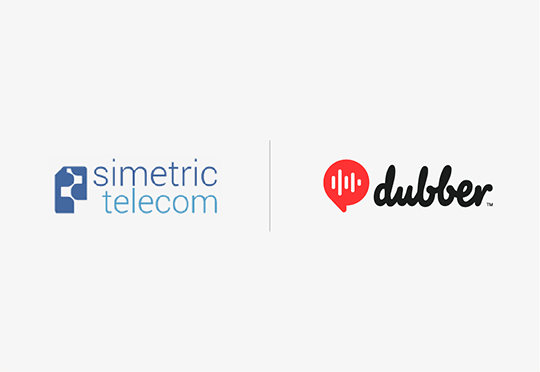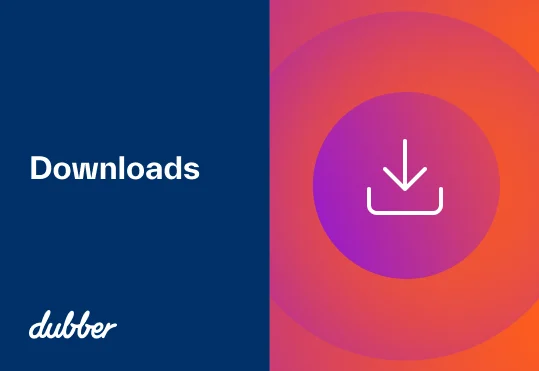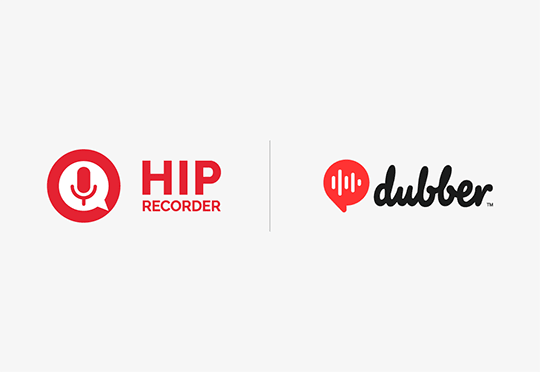
The benefits of call recording are now available on demand. Once only provided as an always-on service deployed for regulatory compliance or contact centres, now businesses can choose from a range of call recording plans and capture their calls at the touch of a button.
2018 is set to be a year of digital transformation, when organisations take their first steps into the cloud and begin to reap the benefits. Looking to the future of communication, phone calls will retain their value and advances in speech intelligence technology will allow businesses to unlock their priceless data.
How to record your calls
A move to the cloud means a move away from being tied down: to investment, to storage plans, to bulky equipment. Cloud call recording as a service allows organisations of any size to capture their conversations at an affordable cost. With no on-premise equipment required, Dubber’s call recording can not only be deployed rapidly, but can also be installed without the need for CapEx.
Always on
Always on records all calls, directly from the network. Perfect for regulatory compliance, or for large businesses that want to record calls for training purposes. Team hierarchies can be established, making calls accessible only to admins, supervisors, and the individual users who made the calls.
On demand
On-demand recording is a user-initiated service that only records selected calls. The user can decide to record a conversation before or during a call using a function on their desktop or handset. Recorded calls are stored in the same way as other team members and have a hierarchy of access permissions. Each individual user only has access to their own calls, while supervisor and admin permissions grant access to the calls of an entire team.
Playback
Specially designed for individuals, Playback gives users the gift of hindsight with the option to save a record of their calls for up to three days after the call has been made. They can then access them through their own private dashboard using a web, mobile, or deskphone app.
Zoe
Zoe transforms everyday phone calls into valuable data assets for both businesses and individuals. A comprehensive suite of speech intelligence modules, Zoe lets users unlock the insights held within the data of voice calls through its key features: Smart Search, Keywords (coming soon), and Sentiment (coming soon). Businesses can examine their customer communications to increase their understanding of their interactions and discover areas of potential improvement.

Dubber Completes $6.5 Million Placement with Institutional and Sophisticated Investors
Dubber Corporation Limited (ASX: DUB) is pleased to announce that it has received commitments for a $6.5 million capital raising placed with institutional and sophisticated investors. The capital raising will result in the placement of 17,143,572 new fully paid ordinary shares at an issue price of $0.35 per new share (with a further 1,428,572 subject to shareholder approval) under the Company’s current placement capacity in accordance with Listing Rule 7.1 (5,435,343 shares) and 7.1A (11,708,229 shares). The price of $0.35 meets the requirements of LR 7.1A.3 in being greater than 75% of the 15-day VWAP.
Settlement of the placement and issue of new shares is expected around Wednesday, 20 December 2017.
The placement was supported by existing shareholders and institutional investors. The funds raised will be used to further expand Dubber’s operations, particularly in North America and Europe where the Company is seeing strong demand for its services and a number of strategic agreements with tier one service providers reach anticipated full deployment in calendar 2018. The Company will also be adding additional staffing and strategic account directors as its cloud call recording and intelligence platform is fully integrated into BroadSoft’s BroadCloud Unified Communications delivery platform.
As part of the capital raising a significant portion was taken by entities managed by James Spenceley, an Australian telecommunications pioneer and founder of Australia’s largest fixed line Telco Vocus Group Limited.
“The adoption of cloud based IP telephony is accelerating globally, a pre-requisite of that successful transition is cloud based call recording. Dubber’s solution is simply world leading and solves a very real problem for Telcos and Vendors looking to transition their clients to the cloud. It is exciting to be able to support a home-grown technology business addressing a global market and validated by some of the world’s biggest telcos and telephony vendors” said Mr. Spenceley.
As part of the capital raising, Managing Director Steve McGovern has subscribed for 1,428,572 shares ($500,000.20) subject to shareholder approval.

The deadline for compliance with MiFID II regulations is upon us and the time to adapt to the new rules is now. This extension of MiFID legislation requires any company or employee to record all calls, across mobile and fixed lines, that include financial advice that could lead to a trade. More regulation shouldn’t mean doom and gloom: smart organisations will see these changes as an opportunity to set themselves apart from their competitors with an honest and trustworthy approach to trading and financial advice.
Compliance is an opportunity, not a burden
With technological advances, businesses have the opportunity to make huge improvements in the way they work and the enforcement of MiFID II regulations are the perfect cue to start. By utilising cloud technology to meet the requirements of the new legislation, financial organisations can turn these regulations to their advantage to create value for their business: at an affordable cost, and with no disruption to their existing processes.
Looking beyond the necessary steps required for MiFID II compliance, financial organisations can actually improve their offering and beat the competition by taking advantage of new opportunities. The benefits of a proactive approach to compliance include:
- Improvements in business and customer service practices
- Setting a higher bar for competitors puts businesses ahead of the game
- Gaining a reputation for best-in-class practice
- An opportunity for new technologies to harness the true value of recorded data
- Risk identification and management
Intelligent call recording goes beyond compliance
By deploying call recording for compliance, organisations can also take advantage of the added benefits that can be accessed. Dubber’s call recording is available with the added intelligence of Zoe: a sophisticated suite of speech analytics tools that can help businesses unlock the data held within their voice calls.
Identifying issues and opportunities
Speech intelligence can be instantly added to Dubber’s cloud call recording, allowing organisations to turn MiFID II compliance to their advantage. Zoe can help businesses to analyse their working practices — identifying issues that can be addressed as well as opportunities for development.
Risk management
With Zoe’s Smart Search functionality, recorded calls company-wide can be searched instantly, no matter the size of the organisation. Keywords associated with financial risk can be identified, highlighting conversations that might contain issues. This kind of monitoring promotes a reassuring environment for the consumer.
A competitive advantage
The aim of the MiFID II legislation is for consumers to regain trust in the financial industry, and financial organisations should jump at the chance to showcase how their company goes above and beyond their competitors. By setting a higher bar for financial practice, organisations can get ahead of the game.
A proactive approach to MiFID II regulations
Compliance with regulations shouldn’t be a reactionary game, with organisations playing catch up to attain the minimum requirements to meet regulations. Those who will lead the market will be those who proactively consider how to provide best-in-class practices that offer a better experience for their customers. With MiFID II following so closely behind the original MIFID legislation, MiFID III can’t be too far behind. By taking a proactive approach to customer service and business development, organisations can use technology to their advantage to stay ahead of the game.

The time to adapt to the new MiFID II rules is now. Together with unified telecom services provider Simetric, Dubber has the solution to help financial services organisations comply with the expanded regulations of MiFID II.
Delivered through a SIM card, this advanced communications solution gives users the ability to capture all of their mobile conversations as well as their fixed line calls – a key component of MiFID II compliance. The regulations require all conversations that result or might result in transactions to be recorded, and includes equipment provided to, or authorised for the use of, employees and contractors of the firm – mobile phones being a key example of this clause. This new service will allow users to have a single number across their mobile and fixed line platforms, with Dubber communication capture available across all of their devices.
As MiFID II regulations have extended their coverage to include independent financial advisors, a call-recording solution that can be implemented quickly and easily through a SIM card is an ideal solution. Dubber + Simetric’s call recording solution is cloud-based, enabling users to deploy the service rapidly.
An extra feature of this advanced communications solution is Zoe, Dubber’s powerful speech intelligence suite, which enables users to search through their calls and analyse the voice data that has been captured. Calls related to trades can be quickly located — a crucial component of MiFID II compliance — using a variety of search criteria, but the power of Zoe doesn’t stop there. Zoe’s capabilities are developing every day, and new functionality will allow users to gain valuable insights in a variety of ways from their conversations.
At a time when organisations must be seen to be taking compliance seriously, implementing a comprehensive solution that records communications across devices is an ideal way to ensure your firm is ready for MiFID II. Not only will the worry of compliance be lifted, but consolidating your conversations and using one number for all communications will streamline your workflow.

Used as a new way to deliver unified communications functionality through web and mobile applications, WebRTC has quickly grown in popularity in recent years and is utilised by social platforms such as Facebook and Slack. WebRTC began as a free project that aimed to provide high quality real-time communications (RTC) capabilities between peer-to-peer connections, built into web browsers and mobile applications using simple application programming interfaces (APIs) and a common set of protocols. The growth of the global WebRTC market is expected to be over 40% between 2016 to 2023 (see chart below).

Source: Credence Research
This initiative enables audio, video conferencing, file transfer, instant messaging and also screen sharing without the plugins such as Adobe Flash that have always been required in the past. WebRTC can be seen all over the internet, such as on websites that allow consumers to access contact centre agents through their browser. Live customer assistance can be provided through a chat service or through a WebRTC call that can be placed directly through the browser. It is also what powers calls through instant messaging services such as Slack and enables the voice and video chat that is built in to Facebook’s Messenger.
Previously, this type of plugin-free RTC technology has only been available to large enterprises, as licensing fees for the audio and video technologies required were prohibitively expensive. WebRTC is the first of its kind; allowing a powerful RTC standard to be available to the public as open source. It has the potential to create a new wave of applications and change the way we communicate.
WebRTC runs on JavaScript, which can be easily incorporated into any web application to enable the functionality through a JavaScript API. The services that WebRTC provides can also work simultaneously so that, for example, files can be shared during a teleconference.
Intentionally developed to not provide any preference of protocol, WebRTC is compatible with a variety of existing communications infrastructure such as session initiation protocol (SIP), which is widely used for voice and videoconferencing over IP networks. This means that, just like other VoIP calls, WebRTC calls can be recorded by Dubber’s communication capture software.
What are the advantages of WebRTC?
WebRTC has many advantages, including significantly better video quality than Flash, session connection speeds that are up to 6x faster, and reduced audio and video latency that enables conversations to feel more natural.
Many web services already have RTC capabilities, but only through plugins. WebRTC doesn’t require any plugins and therefore has none of the download, installation, or update processes, or troubleshooting that usually accompany RTC services.
The simple APIs and protocols of WebRTC have the potential to democratise communication across a range of applications from telephony to gaming.

Customer service is an important area of investment for businesses wishing to differentiate themselves from their competitors. With customer contact largely occurring over the phone, the voice data from conversations with customers has become a valuable business asset. Accessing this data to enhance the customer experience can bring numerous benefits. With legacy call recording solutions this data is more difficult to access, however, call recording services built on a cloud infrastructure have the storage and processing capabilities required to truly harness the voice data collected from customer calls. Accompanied by a speech intelligence solution that can analyse the data, a cloud call recording service can allow an organisation to truly listen to its customers. The global speech analytics market has been growing steadily over the past few years and is set to continue, read on to find out how new technology can improve customer service in contact centres.
Quality assurance
Using speech intelligence software such as Zoe from Dubber, contact centre supervisors can monitor their contact centre agents to ensure they are performing to the best of their abilities. Script adherence is important when staff are given directives to do with how to handle certain situations, or when there is a sales campaign in progress. A feature like Keywords can identify those contact centre agents who adhere to scripts, and show calls that do not contain certain words or phrases.
Zoe’s Sentiment feature analyses the emotions of callers using speech characteristics such as tone, volume, and speed of speech and assigns a positive or negative score to a conversation. This allows businesses to identify negative calls that might be from frustrated callers – an automated process could even be enabled to alert management to follow up on negative calls. Trends in negative calls could be identified to show opportunities for development. As Zoe operates in the cloud, and utilises the processing power of AWS, detailed reports can be created using data from all calls rather than a small sample
Dispute resolution and detail confirmation
Recorded calls can provide definitive proof of what was said in a conversation. While this can be useful for everyday business – replaying calls taken on the go to confirm important details back in the office, or replaying orders to ensure accurate fulfillment – recorded calls are also a vital tool in dispute resolution. Zoe’s Smart search feature can easily scan call archives using a variety of criteria from date of call to a specific word or phrase spoken. This quick search means that disputes are settled as soon as possible.
Staff training
Playing real calls is the most effective training method for new staff. The ability to play an example of an actual phone call gives a realistic insight into the conversations a new contact centre employee can expect in their role. Examples of how to deal with angry callers can be played, with proven methods demonstrated.
Recorded calls can also be helpful for existing contact centre staff. An employee’s own conversations can be replayed to show how a call could be handled differently, while successful calls can be shared with a team for motivation. A culture of self-evaluation can also be nurtured by encouraging employees to replay their own calls and reflect on how they dealt with these customers and issues. Dubber’s web portal allows contact centre agents to access their own calls, and team permissions can be set-up so that supervisors can listen to their team’s calls.
Rewarding excellent staff
Zoe can be a great tool for identifying high-performing staff. With Sentiment’s call scoring, contact centre employees who consistently turn negative calls into positive interactions can be easily identified and rewarded for their great work. First call resolution can be tracked and those contact centre agents that achieve high levels can also be acknowledged.
Not all calls are best handled by the person who answers them and knowing when to transfer is a highly valuable skill. Calls transferred to management can be assessed and staff rewarded when appropriate. This variety of measures can indicate those employees who would make good candidates for promotion.
CRM integration and customer insight
Dubber’s partnerships with service providers such as Mondago allow for easy integration with features that can make life easier for contact centre agents. Mondago are leaders in computer telephony and CRM integration and can help organisations build informed profiles of their customers using data from their calls. Features such as screen population, which displays customer information to contact centre agents, can reduce call time as callers no longer need to state all of their details each time they call.
Dubber’s open API allows easy integration with CRM systems. Customer calls can be stored alongside their order history and personal information for detailed customer profiles that facilitate quick and easy customer service.
Deploying a cloud call recording solution, alongside speech intelligence, can not only improve customer service, but provide insight into the working practices of a business and identify areas of potential growth and development. Contact us to find out how to make the most of your phone calls.

Notice of Annual General Meeting/Proxy Form

Launching at RoutIT Vision this month, HIP Recorder is the latest offering from Netherlands wholesale infrastructure and cloud services provider RoutIT – and it’s powered by Dubber. At an event that was buzzing with interest in the new developments in call recording for individuals and speech intelligence, HIP Recorder is an exciting new product.
This partnership with RoutIT will make Dubber’s cloud call recording as a service available to all RoutIT customers – the HIP Recorder is an affordable option that allows users to retrieve recordings of their calls for up to three days after the call has been made.
RoutIT was founded in 2000 and strives to develop and deliver the most innovative internet, cloud, connectivity and communication solutions. RoutIT works closely with its customers with a personalised approach to providing communication solutions. This new product matches the tailored ideology of RoutIT by providing a unique offering that allows individual users to gain access to the benefits of call recording.
HIP Recorder users can also benefit from the speech intelligence of Zoe – giving them the potential to transform everyday phone calls into valuable data assets. Zoe goes above and beyond traditional call recording to unlock the information held within voice calls – allowing users to search their call archive and automate processes triggered by keywords spoken on calls.
Dubber will be at RoutIT Vision on September 26th and 27th 2017 demonstrating the benefits of call recording for individuals and the endless potential of Zoe. Come and say hello if you are attending!

Unstructured data enables organisations to gain insight into their working practices. The term unstructured data describes information that does not have a set format, unlike its structured counterpart that is made of set data fields such as inventories and orders. Examples of unstructured data include images, and video and audio recordings.
Big Data and its analysis has proven just how vital information is to businesses. Insight into both consumers and the working practices of the organisations themselves can be a valuable asset. With global data estimated to reach over 160 zettabytes (that’s 160 000 000 000 000 000 000 000 bytes) by 2025, learning how to harness this information can set businesses apart from their competitors. These huge amounts of data allow analysts to understand a company’s true potential and more accurately predict growth and risks.
Unstructured data is often linked to structured data to make it easier to process. For example, a headshot of a staff member would be associated with structured data relating to the length of their employment and salary. This allows data to be visualised in a way that can be utilised to gain insights that were previously unimaginable. Data analysis can predict sales results, allow for more accurately targeted marketing campaigns and open up business and product development opportunities.
80% of data is unstructured, and is growing at a far higher rate than that of structured data (see graph below). Unstructured data often requires special tools to sort, search, visualise, and analyse. Unstructured data frequently holds much more information than structured data, and the information is often much more valuable. Due to the difficulties that can arise when accessing unstructured data, an organisation’s systems may need a way to read the data before it can be processed, and extra storage may be required for this more complex data. Companies with on-premise storage may be restricted by the amount of data they can store, and will be forced to make difficult decisions about the information they choose to keep.
Source: IDC
The power of the cloud
Data analysis can be overwhelming and it can be difficult for organisations to understand how to make the most of their data – especially large amounts of unstructured data. With a data management strategy, businesses can ensure they keep up with their competitors and capitalise on the wealth of information held in their data stores.
The analysis of unstructured data can be extremely time-consuming, with specialist data scientists often employed to cleanse and prepare the data before analysis. Employing expensive data scientists is an unlikely step for all but the largest enterprises to take but, with developments in artificial intelligence (AI), unstructured data can now be automatically analysed. These technological advancements allow even small businesses to profit from their valuable stores of data.
Investing in expensive hardware for data storage and processing isn’t practical for the majority of businesses, however, utilising the infrastructure of the cloud can allow organisations to store and process their data without restrictions or the need for CapEx. With dramatically reduced costs, and the scalability to accommodate large amounts of data, companies have the opportunity to experiment with analysis to grow their knowledge and skills.
Introducing Zoe
Automated analysis is now possible with AI becoming an everyday reality. Software can process huge amounts of unstructured data including images, audio and video, and not only report findings but learn as it analyses. AI is an important component in Big Data analysis, with its capabilities expanding to now include emotion recognition.
These new capabilities are exemplified by Zoe, Dubber’s suite of intelligence modules. Specialising in the analysis of voice data, Zoe’s ability to process this kind of unstructured data opens up another channel in the Big Data conversation: Big Voice. Accessing the data in consumer calls allows organisations to truly listen to their customers.
Zoe’s technology is under constant development. Its Smart Search feature is available now, allowing users to search their recorded calls using a variety of criteria from the date and location of the call to specific words that were used during a conversation. Due to be released at the end of 2017 are two more modules: Keywords and Sentiment. Keywords tags specific words and phrases and can be configured to trigger actions when these are spoken through Dubber’s open API. Sentiment identifies the emotions of the participants of a call to create a detailed understanding of their mood throughout a conversation.
Zoe’s analysis of voice opens up the wealth of insight that can be gained from this unstructured data, and allows businesses of all sizes to take advantage of the cloud and experiment with data analysis. Powered by the cloud, the processing potential is limitless.
This week Apple announced it will be bringing face-tracking support to its AR platform ARKit on iPhone X, its new phone launching in celebration of the tenth anniversary of the first iPhone. ARKit allows developers to easily integrate augmented reality (AR) elements into their iOS apps. However, AR has so much more potential than just games on your iPhone: the future of AR might look something like this…
The first thing I do each morning is put in my smart contact lens. At a glance, my day is set out before me with reminders for important appointments. I decide to do some exercise before work this morning, but rather than travelling all the way to the gym I select a pre-designed workout from my personal trainer. As I take my position on my mat, she is projected in front of me to demonstrate the exercises. She times each set and gives me encouragement as I struggle through the reps. After showering, I head to the kitchen for a much-needed breakfast. A reminder to take my medication hovers near the cupboard to make sure I take it with food.
Image: Raygun Studio
I say goodbye to my wife and wish her luck. She works as an architect and today she is showing her design to a client. The weather is nice so I decide to cycle to school, where I work as a teacher. My contact lenses give me details about my route, including traffic conditions and areas of heavy pollution.
Source: Tech in Asia
My class has a trip this morning to a local historic house to learn about life in the past. As we move from room to room, our contact lenses show us a reconstruction of the daily routines of the residents of centuries ago. My pupils are shocked to learn about the lives and long hours of hard working servants and the ways in which the rich passed their time before the internet.
After I have returned the children to school I make my way to the local high street to find somewhere to grab lunch. As I look at different sandwich shops and cafés, ratings and reviews are shown next to them. I choose a salad bar that has been rated highly for its varied vegan selection. On my walk back to school, a tourist asks for directions but can’t speak English. Translated subtitles appear in front of them as they speak and I’m able to reply in English and show them where they need to go.
I call my wife when I finish work to see how her presentation went. Her meeting took place at the proposed construction site so that her design, projected through smart contact lenses, could be seen against the surroundings. Her designs were very well received so I tell her I will cook her favourite meal this evening to celebrate.
Source: Virtually Here
I have to get a blood test after work and, as the appointment is in my calendar, my cycle route is shown to me through arrows that guide me along the road, giving me notice of upcoming turns. At the clinic, the phlebotomist uses an infrared scanner that projects an image of my blood vessels onto my skin to find the vein more easily.
Source: Europe Vein Center
My earlier phone call with my wife has been archived and speech analytics software identifies my cooking plans and creates a shopping list for the ingredients. On the way home my route is altered to take me via a supermarket, and my shopping list hovers over the food as I shop. When I get home I cook dinner, following a recipe projected onto the kitchen counter. The dish specifies exactly how the vegetables should be chopped and when I take out my chopping board, the cutting method is demonstrated so I get it right.
Source: CNBC
After we eat I do some outfit research in preparation for a friend’s wedding. I stand in front of the mirror and see the dresses I have been browsing to judge how they will hang on me. I do the same with makeup styles to see what will suit my face shape. My wife and I then turn our attention to the living room; we decide it needs brightening up with some art and maybe a coffee table. Using our smart contact lenses we can visualise different paintings on the walls to see if they fit with the rest of our decoration, and check that the coffee table we like is the right size for our space. We head to bed excited for the new additions.


